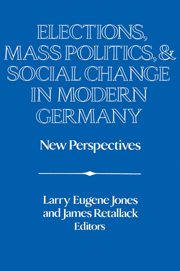Book contents
- Frontmatter
- Introduction
- PART ONE ELECTORAL POLITICS IN AN AUTHORITARIAN REGIME
- PART TWO GENDER, IDENTITY, AND POLITICAL PARTICIPATION
- PART THREE LOCAL DIMENSIONS OF POLITICAL CULTURE
- PART FOUR THE NATIONAL PERSPECTIVE CONTINUITIES AND DISCONTINUITIES
- 13 1918 and All That: Reassessing the Periodization of Recent German History
- 14 Generational Conflict and the Problem of Political Mobilization in the Weimar Republic
- 15 The Social Bases of Political Cleavages in the Weimar Republic, 1919-1933
- 16 The Formation and Dissolution of a German National Electorate
- Index
15 - The Social Bases of Political Cleavages in the Weimar Republic, 1919-1933
Published online by Cambridge University Press: 05 January 2013
- Frontmatter
- Introduction
- PART ONE ELECTORAL POLITICS IN AN AUTHORITARIAN REGIME
- PART TWO GENDER, IDENTITY, AND POLITICAL PARTICIPATION
- PART THREE LOCAL DIMENSIONS OF POLITICAL CULTURE
- PART FOUR THE NATIONAL PERSPECTIVE CONTINUITIES AND DISCONTINUITIES
- 13 1918 and All That: Reassessing the Periodization of Recent German History
- 14 Generational Conflict and the Problem of Political Mobilization in the Weimar Republic
- 15 The Social Bases of Political Cleavages in the Weimar Republic, 1919-1933
- 16 The Formation and Dissolution of a German National Electorate
- Index
Summary
The research project that constitutes the basis of this essay proceeds from the assumption that because of distinct handicaps in Germany's political development there was “neither a homogeneous nor a dominant political culture” in the Weimar Republic but rather - and this is particularly true for the period after 1928 - an extraordinarily “fateful fragmentation [of the political system] into a multiplicity of political subcultures.” The inability of these subcultures either to interact with each other or to establish social and political hegemony, in turn, contributed in no small measure to the rise of National Socialism. This essay uses the methodologies of historical electoral research to investigate the electoral strength of the most important of these political subcultures and to determine the changes that took place in their composition between 1919 and 1933.
It is first necessary to clarify certain assumptions regarding use of the term “political subculture.” In terms of the project as a whole, this concept has been used rather loosely. Together with the conceptually related, though not necessarily coterminous, notions of “political milieu” and “political camp,” the concept of “political subculture” is replete with variations and nuances.
- Type
- Chapter
- Information
- Elections, Mass Politics and Social Change in Modern GermanyNew Perspectives, pp. 371 - 398Publisher: Cambridge University PressPrint publication year: 1992
- 7
- Cited by

